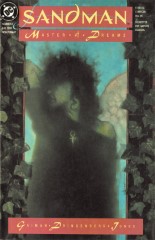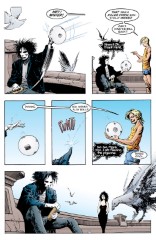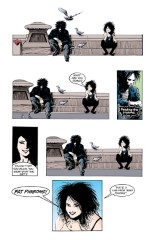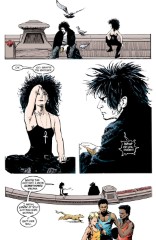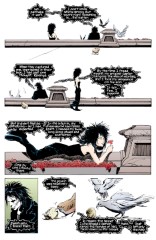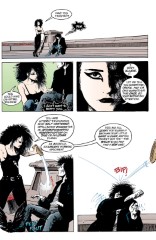Issue 8: "The Sound of Her Wings"
Neil Gaiman, Mike Dringenberg, and Malcolm Jones III
Referred to by Gaiman as the epilogue to More than Rubies
- Eighth story reprinted in Preludes and Nocturnes
- (Also reprinted in earlier editions of The Doll's House)
- Audible Act I Chapter 8
- Netflix Episode 6 (first half)
Note: The Doll's House and Sandman #8 both contain an introduction written by Neil Gaiman explaining the story thus far. The introduction does not appear in Preludes and Nocturnes. Sandman #8 also contains words of praise for Sandman (and Neil Gaiman) from many writers and artists, both of comic books and mainstream fiction. The introduction is illustrated by original art by Mike Dringenberg in #8. The illustrations in The Doll's House are different and more general. The notes below about the illustrations refer to the ones in #8.
Intro, page 1
Upper right:
The Tarot traditionally has 22 Major Arcana, numbered 0 to 21. The Sandman card is done in the style of one of the Major Arcana, but its number 34 suggests that a larger set of Major Arcana exists than is familiar to our world. This ties in with a remark in The Doll's House.
Lower right:
The talisman has many features in common with traditional protective circles. The five pointed star inscribed in a circle is typically a pentacle or pentagram. The lettering around the rim is also traditional; this lettering looks to be runic in nature, which strikes me as somewhat odd. Note that all three tools of Dream have representations on the talisman.
Paragraph 4:
The figure is Destiny.
Paragraph 10:
Neil Gaiman says that the name of Roderick Burgess's house, Fawney Rig, is significant, being "named by Lady Johanna after the manner in which she acquired it." Fawney Rig is a con in which a gilded brass ring is sold for less than it is supposedly worth (if it were gold), but much more than what it is actually worth. The ring would be dropped and picked up before the mark, so it was also referred to as fawney-bouncing. Lady Johanna's con was presumably done on a larger, more complex scale. Lady Johanna Constantine is an ancestor of John Constantine, whom we met in Sandman #3. We will meet Lady Johanna in later issues.
The [Grim] Reaper is a traditional appellation for Death, in this form usually represented as a skeletal figure in a dark robe, wielding a scythe.
Paragraph 13:
We will assume that the reader recognizes and recalls events from earlier issues.
Paragraph 14:
This, however, is new information. My interpretation is that Dream was engaged in some form of conflict with forces unknown when Burgess cast his spell. The weakened Dream was unable to resist the call. Another hint at this prequel is given in Sandman #47. Note that Dream is carrying all his tools at the time of his capture. Neil has said that he is interested in writing a miniseries about these events after the main series is concluded, which indeed happened 17 years after the end of The Sandman with the release of Overture in 2013.
Intro page 2
Paragraph 4:
The information that the Order was embroiled in a scandal when Sykes and Cripps was also mentioned in Sandman #1, page 14, panel 3 which brings the newspaper com Roderick Burgess and Ethel Cripps and describes scandal, which involves the suicide of the museum administrator, which we see in Sandman #1.
Page 1#
Panel 1
This scene occurs in Washington Square Park, in Greenwich Village, New York City. Many specific details in the artwork confirm this. Several people, including this writer, thought that the arch was intended to be L'Arc de Triomphe, in la Place Charles de Gaulle, Paris, France. In fact, that arch is sufficiently larger than the pictured arch that the Washington Square arch could fit underneath it. The Washington Square arch is at the north end of the park, near a T-intersection of Waverly Place and the end of Fifth Avenue, as pictured. The issue was probably drawn from life or from photographs since the details match so precisely. Dream is sitting in a fountain, which is dry in summer only during a drought, which are not uncommon. The dark circular structures on the bottom are caps on the fountainheads. Many people use the fountain in exactly the way Dream is. Considering the lack of crowds, this scene is set on a weekday, or early in the morning. Note the birds. The linkage of Dream with birds is a common motif.
Thus writes "Kai'Ckul" oshinsky@webspan.net:
Firstly, I would like to say how terribly strange it was for me to be literally sitting in Washington Square Park, reading "The Sound Of Her Wings" for the first time. I realized it immediately, and it was one of those "weird shit" moments that Rose Walker always babbles on about. My point, though, is that I found this story immediately interesting, Death in Washington Square Park, since i really dislike that place, since:
a) it is dirty
b) it is either very, very, crowded or very, very empty
c) drug dealers lurk around every corner, and so the cops are always hassling everyone there
d) the fountain never works (even in the summer) and (most importantly)
e) to quote friend of mine: 'every time I go to Washington Square, someone dies.'
'no, really. it's either an O.D. or a heart attack or something, but every damn time I've been there (which is fairly often, and accurate) there's been a corpse there waiting for me.'
Anyway, the point is, Washington Square Park, which I tend to frequent, is a place where many Goths hang out, many of whom look much like Morpheus and Death or their human counterparts, Robert Smith and Souixie Souix. It doesn't matter whether or not Morpheus or Death have wings, real or metaphorical, since they would if we were to suppose them to and wouldn't if we didn't. I'm rambling on, but initially meant to say that Many people who look very much like the two hang there, death is always about, and no one seems to notice.
Page 3#
Panel 6
The young woman is Death, Dream's older sister. Note that Death has subsequently been portrayed with a mark around one of her eyes. Mike Dringenberg credits "Cinnamon" as the visual inspiration for Death in The Doll's House. As we learn later, Death attends all deaths. She is seen attending many deaths in the course of the rest of the series. It is perhaps worth noting that she was not seen at Roderick Burgess's death, nor at the deaths in the diner in Sandman #6; Neil, presumably, had not decided exactly how he wanted to use her. Note, also, that the conversation does not take place in a "gallery", a method of formal communication between the Endless demonstrated later in The Doll's House.
Page 4#
Panel 6
"Mary Poppins" was a Disney film of the 60s which mixed live action and animation in an unprecedented manner. Death's description of the movie is accurate, although she gets the quoted line wrong:
Michael: [about his tuppence] I want it to feed the birds.
Mr. Dawes Sr: Fiddlesticks, boy. Feed the birds and what have you got? Fat birds.
Page 5#
Panel 2
Utterly a banker: "Banker" (or "Merchant Banker") is standard London rhyming slang for "wanker", an unpleasant person (from "wanking off", or masturbation).
Panel 7
Dick van Dyke's line translates to Standard English as "Oh, it's a jolly holiday with you, Mary Poppins!"
Page 6#
Panel 2
Here we clearly see for the first time Death's necklace, which is an ankh, an Egyptian cross that symbolizes life. Note that the chain of the ankh is occasionally missing, as in page 8 panel 3, page 10 panel 2, and others.
Page 7#
Panel 2
As I said earlier, Dream is quick to take revenge, but doubts its value afterward.
Panel 3
The recovery of his tools occupies most of Dream's attention in the first major storyline, More than Rubies, issues #1-7, reprinted in the trade paperback Preludes and Nocturnes.
Page 9#
Panel 4
Dream is an "anthropomorphic personification"; I like that. It means that he is a concept who appears in a form appropriate to those who are conceiving of the concept; i.e. he appears human to humans, as the god of dreams to Martians.
Page 10#
Panel 1
Desire is another of Dream's siblings. We are developing a mythology here, so pay attention :-)
Page 11#
Panel 3
Franklin's been wandering around in the background for a while, but he gets named here. This is his first known appearance; he does not appear later, for reasons that will become apparent.
Page 12#
Panel 5
Dream is at least two hundred years old. We know from his interaction with J'onn J'onzz in #5 that he is at least as old as Martian civilization, which is implied, I believe, to have ended thousands of years ago.
Page 13#
Panel 1
Romany is the name of the Gypsies for themselves and for their language.
The artwork seen here is The Dance>) by Matisse
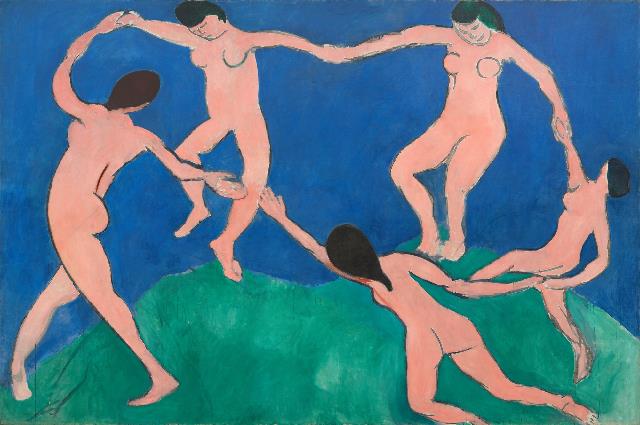
Panel 5
Yid: Yiddish is the traditional lingua franca of the Ashkenazic Jews, those who have ancestors that lived in Germany, Europe and Slavic countries. Yiddish is the closest language to early German but is written in Hebraic characters. The Yiddish people were generally called Ashkenazim or Ashkenazic Jews to distinguish them from the Sephardim or Sephardic Jews, Mediterranean Jews of Spanish origin, expelled from Spain due to religious persecution in 1492. "Yid" means "Jew" in Yiddish. It is a strong racial epithet, particularly when used in Europe by a Gentile. The American equivalent is probably "kike". Here, used by a Jew, "Yid" may be seen as self- deprecating humor.
Page 14#
Panel 1-2
This prayer is a traditional Jewish prayer, the "Sh'ma", said in Hebrew. It is essentially the basic element of faith for Judaism. The translation is "Hear, O Israel, the Lord Our God, the Lord is One." It's a declaration of monotheism, the idea by which Judaism differentiated itself from its neighboring religions. The statement still serves to describe the basic disagreement between Judaism and Christianity's doctrine of the Trinity; "the Lord is One" means not just "as opposed to many" but "as opposed to three-in-one". It is said in every worship service and in numerous other contexts, including, according to tradition, just before death.
Panel 4
Note the painting of the skull, an unusual decoration.
Panel 7
Harry finds out about the afterlife, but we don't. We have learned before that there is a Hell, for example; other DC books, particularly Swamp Thing, have shown other aspects of the afterlife. Season of Mists, in Sandman #21-28, is directly concerned with Hell.
Page 15#
Panel 1
Death is often portrayed in Christian tradition as being an angel, often specifically the archangel Uriel. Angels are traditionally portrayed as being winged. (A modern example of a winged Death is in the movie The Adventures of Baron Munchausen.) The portrayal of a winged Death may predate Christianity.
Page 16#
Panel 7
The comedian is discussing the Batman story A Death in the Family, in which the readers could call a special phone number to vote whether Robin lived or died. By a narrow margin, Robin (the second character to use that name), was voted out.
Panel 8
Note the puns on the fate of the comedian.
Page 17#
Panel 2
"Dying on stage" typically means telling jokes that do not succeed. This is a punning reference to that.
Panel 6
The Sunless Lands would appear to be an appelation for the afterlives. It may be from Greek mythology, the most pleasant section of Hades, where the virtuous dwelt after death. It may also refer to the Sumerian/Babylonian afterlife, which was dusty, dark, and sterile, according to Enkidu's vision in the "Epic of Gilgamesh".
Note the interesting characterization of Dream as more terrible than Death. Quite true, considering that Dream can make a person's life a living nightmare (c.f. Alex Burgess in #1, pp 38-40); whereas Death merely takes people's lives.
"No one here gets out alive" is from a Doors song, "Five to One", from the album Waiting for the Sun (1968). It was also the title of Doors lead singer Jim Morrison's biography, by Jerry Hopkins and Daniel Sugarman, Warner Books, 1980. Note that it may not be original with Morrison, as he was known to widely use literary sources in his writing.
Page 18#
Panel 5
Booful is Eastender slang for "beautiful". (Eastenders are from the East End of London.) Aside from this, which may be a dialectical slip on Gaiman's part, the entire issue takes place in New York City. Or perhaps the character is meant to be British.
Page 19#
Panel 1
Death is a "gift".
Panel 4
Note the graffito: "Dreams make no promises". In conjunction with the dead man, this may be seen as a contrast between the siblings' realms.
Panel 4; page 20 panel 1-2
The song to Death is a verse taken from a papyrus, c. 2000 BC, which contains a work called "Dialogue of a Misanthrope with His Soul". The most accessible reference for this is Joseph Campbell's Oriental Mythology. Campbell cites 19th century German works for his information.
Note that now we know Dream to be "many thousands of years" old; we should by now have the idea that he is immortal and has always existed.
Page 21#
Panel 1
Note that the arch is clearly marked "Erected by the People of the City of New York".
Page 23#
Panel 3
Note what we can see in the background.
Page 24#
Panel 3
The wings that Dream is hearing are the pigeons'. Note that Dream's Greek manifestation is traditionally portrayed as having wings, but that we have no reason to think that this version of Dream does so, as one correspondent suggested.
Credits
- Originally collated and edited by Greg Morrow.
- Peter Trei ptrei@mitre.org gave a long description of Washington Square Park. Tom White twhite@mozart.amd.com, "Nikki" ngustas@hamp.hampshirt.edu, and Connie Hirsch fuzzy@athena.mit.edu also helped in correcting my misidentification of that scene and the locale of the story. Jhemon Lee jlee@nlm.nih.gov spotted the inscription on the arch.
- jasona@sco.COM added some stuff about Greek mythology.
- Michael S. Schiffer mss2@quads.uchicago.edu was extremely helpful in explicating the Jewish cultural elements. Connie Hirsch and William Sherman
- sherman@oak.math.ucla.edu also pointed out the negative connotation of "Yid".
- Jacob Levy ST802099@brownvm.brown.edu differed, saying that "Yid" was not negative in context.
- William Sherman also pointed out the identification of Death with the angel Uriel.
- Tom White, Rob Bakie slinkie@milton.u.washington.edu, Viktor Haag vehaag@crocus.waterloo.edu and Connie Hirsch identified the Doors quote.
- Connie also recalled the Sunless Lands. Zeeshan Hasan zeeshan@occs.cs.oberlin.edu related the Sunless Lands to Gilgamesh.
- Viktor also confirmed the London origin of "booful".
- Jim W Lai jwtlai@watcgl.waterloo.edu found the song to Death.
- Many people corrected a major typo in the archive. Ravi Thiagarajan sthiagar@bronze.ucs.indiana.edu corrected a minor typo as well.
- Sverker Wiberg sverkerw@Minsk.DoCS.UU.SE pointed out the difference in the illustrations accompanying the introduction.
- Ron Dippold RDIPPOLD@CANCUN.QUALCOMM.COM pointed out the amazing disappearing-reappearing ankh chain, Harry's unusual painting, some puns and a graffito. He indicates, without reference, that the winged death predates Christianity.
- Ian O'Brien izo30@juts.ccc.amdahl.com pointed out some rhyming slang, noted that Dream and Death didn't use their galleries, and saw the linkage between Dream and birds.
- Lance Smith lsmith@atto.cs.umn.edu explained the Fawney Rig con.
- Nils Helge Kielland Brobakk nilsbr@ifi.uio.no pointed out the connection with #47, corrected some typos, asked for a transcription, and pointed out Harry's picture and puns on the comedian.
- Timothy Tan aka TiTan <_> -M2001- <_> 083285@bud.cc.swin.edu.au
- "Kai'Ckul" oshinsky@webspan.net wrote about Washington Square Park.
- Ralf Hildebrandt added many more details.
- Richard Munn corrected Death about pigeons, added the note about Overture, the possibility of the baby's mother being British, Identified Harry's Matisse print, and noted Franklin in the background (and foreground) on p23.
Last modified by Richard Munn on 2023-09-07 - Formatting fix
[edit this page] [page history]
